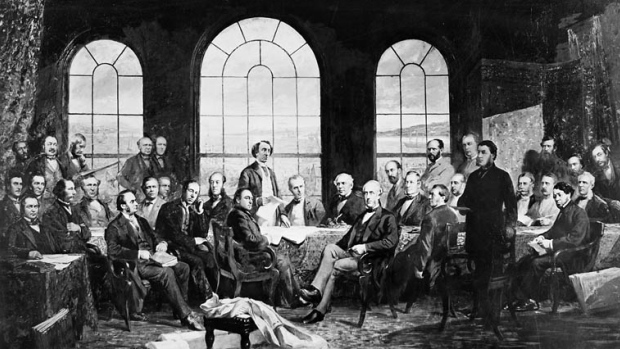A View of Toronto in Summer Months
TRANSCEND MEMBERS, 28 Aug 2017
Dr Ravi P Bhatia – TRANSCEND Media Service
21 Aug 2017 – Soon after I landed in Toronto, I was informed that Canada is celebrating its 150th year anniversary. I was surprised to know this because I thought the city and Canada are much older than 150 years. But I was told that Canada became independent of the British rule 150 years ago. And the lower and upper parts of Canada merged into one country called Canada. Leaders came together in Quebec City at that time to agree to the British North America Act.
On July 1, 1867, it was just four provinces (Ontario, Quebec, Nova Scotia and New Brunswick) that comprised the new Dominion of Canada. Other provinces have become part of Canada later, the last was Nunavut that merged in 1999.The sovereignty of Canada was achieved only recently in 1982 when Queen Elizabeth signed the proclamation in the presence of the Prime Minister Pierre Trudeau. This allowed Canada to amend its constitution without British approval.
Toronto is the biggest city of the country with a population of about 6 million if one includes the people living in the city and its suburbs. It is also the capital of the province of Ontario although the capital of the country is Ottawa also located in Ontario. Like all modern big cities Toronto has many educational institutes, big finance and business centres, multi-storied buildings. It is one of the most multicultural and cosmopolitan cities of the world attracting people from many counties – China, India, Italy, Germany, Thailand, Japan and many others from Africa and Latin America. In fact I was surprised to meet two people whom I met by chance and picked up a brief conversation with. Both were from Eritrea, which is a small country on the Red Sea in Africa bordering Ethiopia and Sudan.
The presence of China and its people is quite obvious in Toronto – there are probably two Chinatowns where one sees many shops, restaurants belonging to Chinese people and written in both English and Chinese languages. One can also see restaurants of other countries especially India, Thailand, Philippines and of course from USA with its popular brands McDonald, KFC etc. I had thought that the chain Tim Horton’s also belonged to USA but the person I spoke to proudly answered that it was a Canadian chain of restaurants.
Like many modern European cities Toronto is a happy blend of modern skyscrapers and colonial British or French architecture. The difference between the two architectures is obvious to even a novice like me. The skyscrapers are tall sometimes as high as 100 floors built of shining metal and glass. The earlier architecture buildings built of stone and bricks, look grand and majestic. There are several churches and Catholic cathedrals dotting most parts of the city but look deserted in comparison to the modern malls, finance and commerce centres. The University of Toronto (U of T) also has grand buildings built in Gothic or Roman style. It was originally founded in 1827 as Kings College but acquired its present name only in 1850. It is recognized worldwide as an outstanding institution of teaching and research.
The city also has beautiful beaches overlooking the Ontario Lake in many parts of the city. These are clean and spacious with open spaces, parks and a lot of greenery (in summer months). Coming from a crowded place like India I am overwhelmed by the spaciousness and greenery of these places. There are people running or cycling around but relatively few in comparison to the vastness of these beaches.
Another memorable place is the Scarborough Bluffs with the majestic bluffs (pointed rocks) along which water flows down into the Ontario Lake. Again the place is vast, green and has many benches to sit down and enjoy the scenery. Most of these benches have been donated by some citizens in memory of their father or mother or some important person. An unforgettable sight was the mist that seemed to be playing hide and seek on the rainy day that I went to see these Bluffs.
As mentioned earlier the city hosts people from many countries. But one thing that strikes a visitor is the scantily dressed men and women in the warm weather. Some walk occasionally with their children being pushed in the baby carriages or with their pet dogs. One sees many people – men and women of all ages having dogs as pets. These dogs are of different sizes and breeds; there is as much diversity to be seen in these pets as in the citizens of Toronto. In fact it appears to an outsider that people love dogs more than other human beings.
People walk fast with determination without glancing in any direction except the streetlights that allow pedestrians the right of way over vehicular traffic. Apart from cars on the roads, the presence of cyclists is encouraging. Cycling is good for health and the environment. But the benefit of cycling or jogging, is negated by a large number of smokers everywhere. While there are signs asking pet owners to pick up dog poop, there are no signs as to where the cigarette butts are to be thrown. One sees them littering all over and dirtying the city.
Finally what can one say in conclusion about this historic city? It is a great city with ancient buildings, modern malls, enticing beaches, open spaces, beautiful parks and trees. The city is a mélange of people from all over the world living in peace and harmony. Wonderful to spend some time here, meet the people and enjoy the sights and different cuisines.
___________________________________________
 Dr Ravi P Bhatia is a member of the TRANSCEND Network for Peace, Development and Environment, an educationist and peace researcher. Retired professor, Delhi University. ravipbhatia@gmail.com
Dr Ravi P Bhatia is a member of the TRANSCEND Network for Peace, Development and Environment, an educationist and peace researcher. Retired professor, Delhi University. ravipbhatia@gmail.com
This article originally appeared on Transcend Media Service (TMS) on 28 Aug 2017.
Anticopyright: Editorials and articles originated on TMS may be freely reprinted, disseminated, translated and used as background material, provided an acknowledgement and link to the source, TMS: A View of Toronto in Summer Months, is included. Thank you.
If you enjoyed this article, please donate to TMS to join the growing list of TMS Supporters.

This work is licensed under a CC BY-NC 4.0 License.

As a Canadian, I appreciate your flattering story about your experiences in Toronto. There are however some key realities missing. The “place” of Toronto far precedes colonization and the 1867 BNA Act. Toronto continues to be home to Indigenous peoples, as it has for millennia.
A simple google search brings one to an informative U of T site: http://guides.library.utoronto.ca/Toronto
It provides a lot of information including this quote:”I would like to acknowledge this sacred land on which the University of Toronto operates. It has been a site of human activity for 15,000 years. This land is the territory of the Huron-Wendat and Petun First Nations, the Seneca, and most recently, the Mississaugas of the Credit River. The territory was the subject of the Dish With One Spoon Wampum Belt Covenant, an agreement between the Iroquois Confederacy and Confederacy of the Ojibwe and allied nations to peaceably share and care for the resources around the Great Lakes.
Today, the meeting place of Toronto is still the home to many Indigenous people from across Turtle Island and we are grateful to have the opportunity to work in the community, on this territory.
Revised by the Elders Circle (Council of Aboriginal Initiatives) on November 6, 2014″
The conflict and violence of colonization in Canada continues, and too often is still conflict-by-omission. Hope that this information helps to provide contextual information. Peace studies of any form requires Indigenous perspectives if it is to promote positive peace, and I hope our field can continue to promote Indigenous realities.
Ehkosi